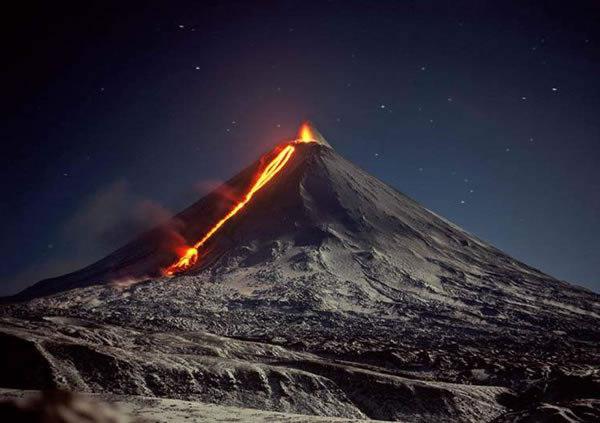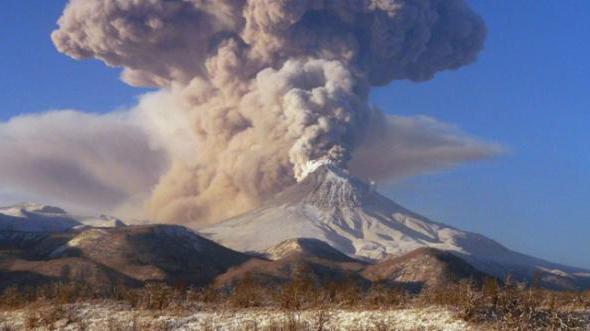Shiveluch is the northernmost active volcano in Kamchatka, and one of the largest on the peninsula. The diameter of its base is fifty kilometers. It consists, as it were, of two parts - Old and Young Shiveluch.
The dimensions of the old volcano
The old Kamchatka volcano Shiveluch is a stratovolcano. It is composed of roughly clastic material, which is interbedded with lava. This natural structure is crowned with a large caldera, whose diameter is nine kilometers. The ledges of her very well preserved, their height varies from hundreds of meters to one and a half kilometers in the region of the main peak. In the process of its formation, more than sixty cubic kilometers of pyroclastic material, spreading over a rather large territory, were thrown out of the bowels of the Earth: it reaches the bed of the Kamchatka River and even further.
Dimensions of a young volcano
At the bottom of this caldera closer to its northwestern edge is the young Shiveluch volcano. It is represented by several extrusive merged domes (Double, Suelich, Central and others) with insignificant lava flows, which have andesitic and andesitodacite compositions. The diameter of the base of this formation is seven kilometers. In 1964, the Shiveluch volcano erupted , as a result of strong explosions, these domes were almost completely destroyed, and in their place a huge double crater formed. Its diameter was 1.7 kilometers for the northern part and 2 kilometers for the southern. As a result of the eruption, material was thrown from the bowels, which was deposited with a continuous cloak on the southern slope, its thickness being from one to fifty meters. The coverage area was more than a hundred square kilometers, and the volume was one and a half cubic kilometers. In 1980, a new extrusive dome, which consists of andesite, began to form inside the northern crater. The growth of this education continues to this day. It is accompanied by explosions of various powers. The most active squeezing of the dome took place in 1993. Then he occupied almost the entire territory of the northern crater.

The history of the volcano
Given the above structure, the Shiveluch volcano is classified as a volcanic structure of the Somme-Vesuvius class. This formation is the largest building of this type. The emergence and development of the volcano, according to geologists, occurred during the Upper Pleistocene, about seventy thousand years ago. The most serious catastrophic eruptions occur with a frequency of one hundred to three hundred years. The last of them was noted in 1854 and in 1964, that is, the interval was 110 years. Medium-strength and weak eruptions occur much more often, usually they are accompanied by the growth of extrusive domes. This is currently observed.
General information: where is the Shiveluch volcano?
By the mass and volume of erupted products, the frequency of strong eruptions, and the rate of removal of matter, this natural formation is one of the most unique volcanoes in Kamchatka and the Kuril Islands. This active ancient geological object is one of the largest on the peninsula. Shiveluch is located eighty kilometers north of Klyuchevsky volcano. It is located on the Kamchatka River, in the middle of a lowland covered by swamps stretching for many tens of kilometers. If the artist had the goal of depicting in the guise of a natural object an offended life, an evil old man, then for nature he should take the Shiveluch volcano. This is a huge natural object, consisting of cone formations of different types and ages, riddled with gorges, craters and dips, existed for many thousands of years, still continuing to erupt from time to time by catastrophic eruptions that destroy all life.
Forming parts
After the formation of the main cone of the volcano as a result of failures and explosions in its southern part, an extensive caldera was formed. A young cone appeared inside. Later, another crater caldera grew in the primary caldera. She destroyed part of a young cone. Here in this place, as the most delicate, and subsequent eruptions began to occur. The part of the ancient cone that has been preserved to this day is called the “Main Peak”, it is the highest point of this geological object. A younger cone is called "Crater Peak." The height of the Shiveluch volcano at the highest point is 3335 meters, and in its youngest part - 2700 meters.
Eruption history
The eruption of the Shiveluch volcano in Kamchatka is explosive. In the last century, emissions occurred in 1925, 1944, 1950, 1964. The last eruption was very short, but extremely strong. As a result, the explosive cloud was raised to a height of fifteen kilometers and moved towards the ocean. Bright lightning constantly cut through its thickness. The entire territory east of the volcano, up to Ust-Kamchatsk and even further, plunged into darkness. An extremely large amount of blasted rock was thrown over a 15-kilometer distance, it covered the earth with a thick layer, which in places reached from several to tens of meters. All shrubs and forests were either buried or burnt, all living things that could not escape or fly away in advance died. It is known that many birds and animals can foresee the approach of earthquakes and volcanic eruptions: they crawl out of their holes, begin to show anxiety, tend to get out of the room. So, the catastrophic eruption of the Shiveluch volcano in November 1964 was preceded by seismic shocks that began a month before the emissions themselves. Every day, their intensity increased. And two days before the eruption, the amount reached more than a hundred per day. How did the animals behave at this time?

From the stories of old-timers
Here is what the local hunter A. M. Chudinov told (at that time he was nineteen years old). Two or three days before the eruption, one could observe a massive and very unusual transition of bears from the left bank of the river to the right-bank valley of Kamchatka. And this despite the fact that in November all the animals lay in hibernation, however, a premonition of an impending disaster forced them to leave their settled warm dens and go into forests that were hungry and cold for them in winter. At the same time, the number of other animals, such as hares and foxes, significantly increased on the right bank. Apparently, they also migrated from under Shiveluch.
Immediately before the start of the eruption, it was possible to visually observe increased seismic activity. So, according to the stories of the inhabitants of Klyuchi, located quite high above sea level, it was seen how a series of waves passed on the surface of a large, covered with ice Lake Kurchazhnoye, lying on the other side of the river.
After the eruption of 1964, only fumarole activity was observed on Shiveluch. The volcano itself is located in remote areas, it is visited by rare expeditions.
2014th
On the morning of June 1, 2014, the Shiveluch volcano made a powerful ash discharge. Its height was more than seven kilometers. Further, the train began to spread in a southeast direction to the Kamchatka Gulf. Today, this geological object is assigned an orange code (one of the most dangerous). Its activity began to increase since 2009, at which time a crevice 30 meters deep formed on the top. Based on the increase in seismic activity, scientists conclude that at the moment there is "preparation" for the next powerful eruption of Shiveluch.